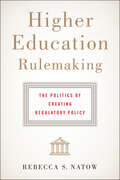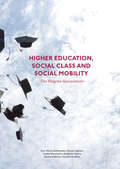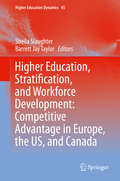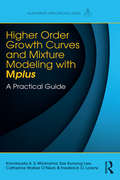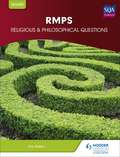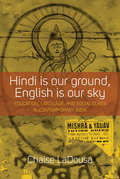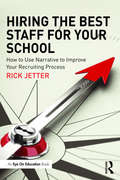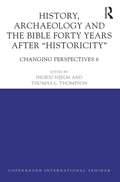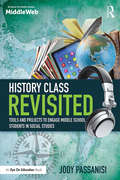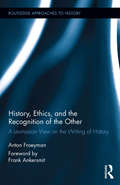- Table View
- List View
Higher Education Rulemaking: The Politics of Creating Regulatory Policy
by Rebecca S. NatowAn in-depth look at how federal regulatory policy for higher education is drafted, influenced, and enacted.Many higher education academics and administrators have only vague notions about how the federal government makes regulations governing colleges and universities in the United States, and yet these regulations control many important aspects of the operation of these institutions. What happens after legislation affecting higher education is signed into law? How are specific provisions implemented—especially when the statute’s details are unclear? And who determines the details of the programs that a particular law has authorized? In this concise and informative book, higher education policy expert Rebecca S. Natow explores the how and why of the federal regulatory policymaking process as it pertains to higher education, financial aid, and student loan debt. Drawing on in-depth interviews with policy and higher education actors, as well as an extensive review of specific regulations and documents, Natow explains who influences higher education rulemaking and how their beliefs and surrounding contexts guide the policies they enact. She also examines the strategies and powers employed during the process, reveals how technology affects the creation of higher education rules, delves into the multifaceted implications of regulation for students and institutions, and discusses future prospects for higher education rulemaking.The first comprehensive, research-based account of this important policymaking process, Higher Education Rulemaking will serve as a valuable resource for scholars, researchers, policymakers, and higher education professionals.
Higher Education, Social Class and Social Mobility
by Ann-Marie Bathmaker Nicola Ingram Jessie Abrahams Anthony Hoare Richard Waller Harriet BradleyThis book explores higher education, social class and social mobility from the point of view of those most intimately involved: the undergraduate students. It is based on a project which followed a cohort of young undergraduate students at Bristol's two universities in the UK through from their first year of study for the following three years, when most of them were about to enter the labour market or further study. The students were paired by university, by subject of study and by class background, so that the fortunes of middle-class and working-class students could be compared. Narrative data gathered over three years are located in the context of a hierarchical and stratified higher education system, in order to consider the potential of higher education as a vehicle of social mobility.
Higher Education, Stratification, and Workforce Development
by Sheila Slaughter Barrett Jay TaylorThis work analyses how political economic shifts contribute to competition within higher education systems in the US, EU, and Canada. The authors highlight competition for prestige and public and private subsidies, exploring the consequences of these processes through theoretical and empirical analyses. Accordingly, the work highlights topics that will be of interest to a wide range of audiences. Concepts addressed include stratification, privatization of formerly public subsidies, preference for "high tech" academic fields, and the vocationalization of the curriculum (i. e. , Science, Technology, Engineering and Mathematics: [STEM] fields, selected professions, and business) rather than the liberal arts or the Humboldtian vision of the university. Across national contexts and analytic methods, authors analyze the growth of national policies that see universities as a sub set of economic development, casting universities as corporate research laboratories and education as central to job creation. Throughout the volume, the authors make the case that national and regional approaches to politics and markets result in different experiences of consequences of academic capitalism. While these shifts serve the interests of some institutions, others find themselves struggling to meet ever-greater expectations with stagnant or shrinking resource bases.
Higher-Order Growth Curves and Mixture Modeling with Mplus: A Practical Guide (Multivariate Applications Series)
by Kandauda K.A.S. Wickrama Tae Kyoung Lee Catherine Walker O’Neal Frederick O. LorenzThis practical introduction to second-order and growth mixture models using Mplus introduces simple and complex techniques through incremental steps. The authors extend latent growth curves to second-order growth curve and mixture models and then combine the two. To maximize understanding, each model is presented with basic structural equations, figures with associated syntax that highlight what the statistics mean, Mplus applications, and an interpretation of results. Examples from a variety of disciplines demonstrate the use of the models and exercises allow readers to test their understanding of the techniques. A comprehensive introduction to confirmatory factor analysis, latent growth curve modeling, and growth mixture modeling is provided so the book can be used by readers of various skill levels. The book’s datasets are available on the web. Highlights include: -Illustrative examples using Mplus 7.4 include conceptual figures, Mplus program syntax, and an interpretation of results to show readers how to carry out the analyses with actual data. -Exercises with an answer key allow readers to practice the skills they learn. -Applications to a variety of disciplines appeal to those in the behavioral, social, political, educational, occupational, business, and health sciences. -Data files for all the illustrative examples and exercises at www.routledge.com/9781138925151 allow readers to test their understanding of the concepts. -Point to Remember boxes aid in reader comprehension or provide in-depth discussions of key statistical or theoretical concepts. Part 1 introduces basic structural equation modeling (SEM) as well as first- and second-order growth curve modeling. The book opens with the basic concepts from SEM, possible extensions of conventional growth curve models, and the data and measures used throughout the book. The subsequent chapters in part 1 explain the extensions. Chapter 2 introduces conventional modeling of multidimensional panel data, including confirmatory factor analysis (CFA) and growth curve modeling, and its limitations. The logical and theoretical extension of a CFA to a second-order growth curve, known as curve-of-factors model (CFM), are explained in Chapter 3. Chapter 4 illustrates the estimation and interpretation of unconditional and conditional CFMs. Chapter 5 presents the logical and theoretical extension of a parallel process model to a second-order growth curve, known as factor-of-curves model (FCM). Chapter 6 illustrates the estimation and interpretation of unconditional and conditional FCMs. Part 2 reviews growth mixture modeling including unconditional growth mixture modeling (Ch. 7) and conditional growth mixture models (Ch. 8). How to extend second-order growth curves (curve-of-factors and factor-of-curves models) to growth mixture models is highlighted in Chapter 9. Ideal as a supplement for use in graduate courses on (advanced) structural equation, multilevel, longitudinal, or latent variable modeling, latent growth curve and mixture modeling, factor analysis, multivariate statistics, or advanced quantitative techniques (methods) taught in psychology, human development and family studies, business, education, health, and social sciences, this book’s practical approach also appeals to researchers. Prerequisites include a basic knowledge of intermediate statistics and structural equation modeling.
Higher RMPS: Religious & Philosophical Questions
by Joe WalkerThe only resource for religious and philosophical questions at Higher level, by a bestselling author and expert in the field.Joe Walker's new full colour book provides comprehensive coverage of the newly designed CFE Higher in Religious, Moral and Philosophical Studies, but is also ideal for students across Scotland studying key topic areas in Religious and Philosophical Questions as part of the broad general education and the senior phase of RME. The book:Offers a lively, accessible and engaging style with appropriate humour that reflects real-life situations and moral issuesHighlights the importance of dealing with varieties of belief within religious traditionsDeals with up-to-date contemporary and topical issues in a highly practical manner
Hindi class 10 - GSTB: हिंदी कक्षा 10 - जीएसटीबी
by Gstbપ્રસ્તુત પાઠ્યપુસ્તક ધોરણ 10 ના હિન્દી વિષય નું પાઠ્યપુસ્તક છે જેમાં ૨૩ પાઠ આપેલ છે.
Hindi class 11 - GSTB: हिन्दी कक्षा 11 - जीएसटीबी
by Gstbઆ પુસ્તક ધોરણ 11 નું હિન્દી વિષય નું પાઠ્યપુસ્તક છે .
Hindi class 11 - GSTB: हिंदी कक्षा 11 - जीएसटीबी
by Gstbसाधो, देखो जग बौराना प्रस्तुत पद में कबीर ने अपने युग में व्याप्त हिन्दू-मुस्लिम धर्म की विसंगतियों तथा अन्तर्विरोधों, धार्मिक संकीर्णताओं, बह्यांडम्बरो आदि का खुलकर विरोध करते हुए धर्म के ठेकेदारों को आत्मज्ञान प्राप्ति की नसीहत दे रहे हैं | बापू की कुटिया में प्रस्तुत पाठ ‘बापू की कुतिया’ में लेखक को गांधीजी के जीवन-काल में उनसे न मिल पाने का रंज है तो दूसरी और उनकी अनुपस्थिति में कुटिया की हर वस्तु को आत्मसात करने का सुअवसर पाकर अपने आप को भाग्यशाली मानते हैं पुरानी चीजों के पक्ष में | प्रस्तुत कविता में सच के साथ मनुष्यता को बचाये रखने के लिए निरंतर संघर्ष करता मिलता है | चन्द्रशेखर आज़ाद प्रस्तुत संस्मरण में लेखक ने चन्द्रशेखर आज़ाद से जुडी हुई स्मृतियों के माध्यम से उनके जीवन व्यक्तित्व तथा उनकी निडरता पर ट्टष्टिपाट किया है शिक्षक के नाम पत्र यह पत्र अमेरिका के राष्ट्रपति अब्राहम लिंकन ने अपने पुत्र के अध्यापक को लिखा है- जिसमें अध्यापक के द्रारा किसी विधार्थी को ईमानदारी, विवेकशील, परिकश्रमी, धैर्यवान, आत्मनिर्भर बनाने के साथ-साथ अपने विचार स्वयं बनाने पर बल दिया गया है |भारतमाता की जय प्रस्तुत लेख में अनपढ़ ग्रामीण लोग ‘भारतमाता की जय’ का नारा तो लगाते हैं किन्तु भारतमाता के सच्चे स्वरूप तथा उनकी वत्सलता से अनजान हैं |परशुराम – लक्ष्मण संवाद प्रस्तुत अंश ‘रामचरितमानस’ के ‘बालकांड’ से लिया गया है | रामचन्द्र द्रारा शिवजी के धनुष तोड़े जाने पर परशुरामजी के क्रोध का वर्णन है पंचलाइट ‘पंचलाइट’ रेणुजी की गिनीचुनी प्रसिद्ध कहानियाँ में से एक है | पंच के न्याय दंड-जुरमाना, नयी चीज के आनेपर धर्म-ध्यान और कीर्तन के माध्यम से ग्रामजीवन का बखूबी चित्रण हुआ है; गाँव के अनपढ़ लोगों में अज्ञान जातिगत देष को उजागर किया है चंपा काले काले अच्छर नहीं चीन्हती यहाँ संकलित कविता ‘चम्पा काले-काले अच्छर नहीं चीन्हती’ में गाँव की अनपद लड़कियों और सामान्य-जन को नायकत्व प्रदान किया गया है |अजन्ता प्रस्तुत प्रवास वर्णन में अजन्ता की गुफाओं का परिचय मिलता है नीति के दोहे यहाँ ‘नीति के दोहों’ में आचरण की शुद्धता पर बल दिया है | जीवन का सत्य उजागर करनेवाले इन संकलित दोनों में शक्ति की महता, मैत्री, संगति का फल, वाणी का प्रभाव, योग्यता, बड़े-छोटे का भेद दरिद्रता, कृपण, जिहवा की विशेषता, एवं उदारता का मार्मिक चित्रण है | दु:ख, कदम मिलाकर चलना होगा , नन्हा–सा पौधा,बाज़ लोग, कल्पना-शक्ति,गज़ल, पहली चूक,डंका,दो लघु-कथाएँ .वगेरे पाठ भी सुन्दर तरीकेसे प्रस्तुत किये गये है.
Hindi class 5 - RBSE: हिंदी कक्षा 5 - आरबीएसई
by Rajasthan State Textbook BoardHindi Textbook for Class 5
Hindi class 6 - RBSE: हिंदी कक्षा 6 - आरबीएसई
by Rajasthan State Textbook BoardHindi Textbook for Class 6
Hindi class 7 - RBSE: हिंदी कक्षा 7 - आरबीएसई
by Rajasthan State Textbook BoardHindi Textbook for Class 7
Hindi class 8 - RBSE: हिंदी कक्षा 8 - आरबीएसई
by Rajasthan State Textbook BoardHindi Textbook for Class 8
Hindi class 9 - GSTB: हिंदी वर्ग 9 - जीएसटीबी
by Gstbभाषाकीय नये अभ्यासक्रम का एक उदेश्य यह है, कि इस स्तर के छात्र व्यवहारिक भाषा का उपयोग करने के साथ-साथ अपनी भाषा-अभिव्यक्ति को विशेष प्रभावशाली बनाएँ । साहित्यिक स्वरूप एवं सर्जनात्मक भाषा का परिचय के साथ-साथ हिन्दी भाषा की खुबियों को समझकर अपने स्व-लेखन में प्रयोग करना सिखें, इस लिए स्व-लेखन के लिए छात्रों को पूर्ण अवकाश दिया गया है । समझकर अपने स्व-लेखन में प्रयोग करना सिखें, इस लिए स्व-लेखन के लिए छात्रों को पूर्ण अवकाश दिया गया है । इस पाठ्यपुस्तक को रुचिकर, उपयोगी एवं क्षतिरहित बनाने का पूरा प्रयास मंडल द्वारा किया गया है, प्रस्तुत प्रार्थना मे 'सत्यं शिवं सुंदरम्' की भावना के साथ दीन-दुखियों की रक्षा करना, मानवता की उपासना करना, भेदभावों को दूर करना, बैरभाव से मुक्त हो कर विश्वबन्धुत्व की स्थापना करना-जैसे वैश्विक मूल्यों को हस्तान्तरण करने की प्रेरणा देनेवाली यह प्रार्थना मराठी से अनुदित है । प्रस्तुत निबंध में द्विवेदीजी ने यह समझाया है कि तत्कालीन भारतीय समाज में व्याप्त अनाचार केवल बाहरी स्तर पर है ; वास्तव में आज भी लोगो में मानवीय मूल्यो के प्रति आस्था कायम है । अपने जीवन में घटित कुछ घटनाओं के द्वारा बताया है कि हमें निराश नहीं होना चाहिए अपितु हमें जीवन के प्रति आस्थावान बने रहना चाहिए । प्रस्तुत पाठ्यपुस्तक में २४ प्रकरण है पूरक वांचन और स्वाध्याय भी दिये गे है.
Hindi Is Our Ground, English Is Our Sky: Education, Language, and Social Class in Contemporary India
by Chaise LadousaA sea change has occurred in the Indian economy in the last three decades, spurring the desire to learn English. Most scholars and media venues have focused on English exclusively for its ties to processes of globalization and the rise of new employment opportunities. The pursuit of class mobility, however, involves Hindi as much as English in the vast Hindi-Belt of northern India. Schools are institutions on which class mobility depends, and they are divided by Hindi and English in the rubric of "medium," the primary language of pedagogy. This book demonstrates that the school division allows for different visions of what it means to belong to the nation and what is central and peripheral in the nation. It also shows how the language-medium division reverberates unevenly and unequally through the nation, and that schools illustrate the tensions brought on by economic liberalization and middle-class status.
Hindi Language - 3 class 10 - Karnataka Board: हिंदी भाषा - 3 कक्षा 10 - कर्नाटक बोर्ड
by Karnataka Patyapusthaka SanghaHindi Language-3 Textbook for 10th Standard kannada medium Karnataka State
Hindi Language - 3 class 6 - Karnataka Board: हिंदी भाषा - 3 कक्षा 6 - कर्नाटक बोर्ड
by Karnataka Patyapusthaka SanghaHindi language-3 textbook for 6th Standard Kannada medium, Karnataka State
Hindi Language - 3 class 7 - Karnataka Board: हिंदी भाषा - 3 वर्ग 7 - कर्नाटक बोर्ड
by Karnataka Patyapusthaka SanghaHindi Language-3 textbook for 8th standard kannada medium, Karnataka State
Hindi Language - 3 class 8 - Karnataka Board: हिंदी भाषा - 3 वर्ग 8 - कर्नाटक बोर्ड
by Karnataka Patyapusthaka SanghaHindi Language-3 Textbook for 8th Standard kannada medium, Karnataka State
Hindi Language - 3 class 9 - Karnataka Board: हिंदी भाषा - 3 कक्षा 9 - कर्नाटक बोर्ड
by Karnataka Patyapusthaka SanghaHindi Language- 3 Textbook for 9th Standard kannada medium, Karnataka State
Hiring the Best Staff for Your School: How to Use Narrative to Improve Your Recruiting Process
by Rick JetterHiring the Best Staff for Your School moves beyond typical hiring tools—résumés, applications, transcripts, portfolios, and artifacts—and adds effective strategies to the educational leader’s recruiting and hiring toolbox. Jetter hones in on the most crucial but often neglected element of talent searches—knowing candidates’ attitudes and dispositions about students, learning and instruction, leadership, and other crucial educational topics which affect schools today—and provides an innovative model for hiring the best candidates. This book presents a recruitment and hiring process that uses narratives to help school and district leaders delve deeper into understanding the emotions, ideas, reactions, and problem-solving insights of candidates. The ready-to-use resources found in this book, including real examples of the narrative process in action, dialogues, and as a training process, are easy to implement and will strengthen the hiring process to ensure that you recruit and retain the best staff members for any position within your school or district.
History 11th Standard - Tamilnadu Board
by State Council of Educational Research TrainingHistory Textbook for the 11th Standard Students, preparing for Tamil Nadu State Board Exam.
History 12th Standard - Tamilnadu Board
by State Council of Educational Research TrainingHistory Textbook for the 12th Standard Students, preparing for Tamil Nadu State Board Exam.
History, Archaeology and The Bible Forty Years After Historicity: Changing Perspectives 6
by Thomas L. Thompson Ingrid HjelmIn History, Archaeology and the Bible Forty Years after "Historicity", Hjelm and Thompson argue that a ‘crisis’ broke in the 1970s, when several new studies of biblical history and archaeology were published, questioning the historical-critical method of biblical scholarship. The crisis formed the discourse of the Copenhagen school’s challenge of standing positions, which—together with new achievements in archaeological research—demand that the regional history of ancient Israel, Judaea and Palestine be reconsidered in all its detail. This volume examines the major changes that have taken place within the field of Old Testament studies since the ground breaking works of Thomas Thompson and John van Seters in 1974 and 1975 (both republished in 2014). The book is divided in three sections: changing perspectives in biblical studies, history and cult, and ideology and history, presenting new articles from some of the field’s best scholars with comprehensive discussion of historical, archaeological, anthropological, cultural and literary approaches to the Hebrew Bible and Palestine’s history. The essays question: "How does biblical history relate to the archaeological history of Israel and Palestine?" and "Can we view the history of the region independently of a biblical perspective?" by looking at the problem from alternative angles and questioning long-held interpretations. Unafraid to break new ground, History, Archaeology and the Bible Forty Years after "Historicity" is a vital resource to students in the field of Biblical and East Mediterranean Studies, and anyone with an interest in the archaeology, history and religious development in Palestine and the ancient Near East.
History Class Revisited: Tools and Projects to Engage Middle School Students in Social Studies
by Jody PassanisiLearn new approaches to teaching history in middle school so students are more engaged in the big ideas and eager to examine the world around them. Co-published by Routledge and MiddleWeb, this practical guide will help you consider the unique needs of middle schoolers, who are in the midst of many social and emotional changes and need to see why the study of history matters to their own lives. Author Jody Passanisi shares helpful strategies and activities to make your social studies class a place where students can relate to the material, connect past history to present events, collaborate with others, think critically about important issues, and take ownership of their learning. Topics include: Reading and analyzing primary and secondary sources for deeper comprehension of historical issues Developing a written argument and defending it with supporting details and cited sources Examining the social context of a historical event and tracing the historical underpinnings of present day issues Using field trips, games, and Project Based Learning to make learning history a fun and interactive experience Assessing your students’ progress using self-reflection, projects, essays, and presentations The appendices offer resources for each of the topics covered in the book as well as reproducible Blackline Masters of the charts and diagrams, which can be photocopied or downloaded from our website (http://www.routledge.com/products/9781138639713) for classroom use.
History, Ethics, and the Recognition of the Other: A Levinasian View on the Writing of History (Routledge Approaches to History #17)
by Anton FroeymanThis book introduces a new way of looking at the writing of history. Rather than as the production of knowledge or the telling of stories, it sees writing history as an ethical, existential and emotional engagement with the people from the past. The conceptual and philosophical basis for this view is provided by the philosophy of Emmanuel Levinas. In the first part, the view is presented and contrasted with other, competing views, such as those of Hans-Georg Gadamer and Michel Foucault. In the second part, the view is argued for, most importantly by an in-depth discussion of one specific tradition of history-writing (microhistory), and a series of close readings of several classical works from the history of historiography. The third part, finally, explores some of the methodological consequences of this view, and applies it to a non-academic way of dealing with the past, namely historical performance practice in music. The book features a foreword by Frank Ankersmit.
